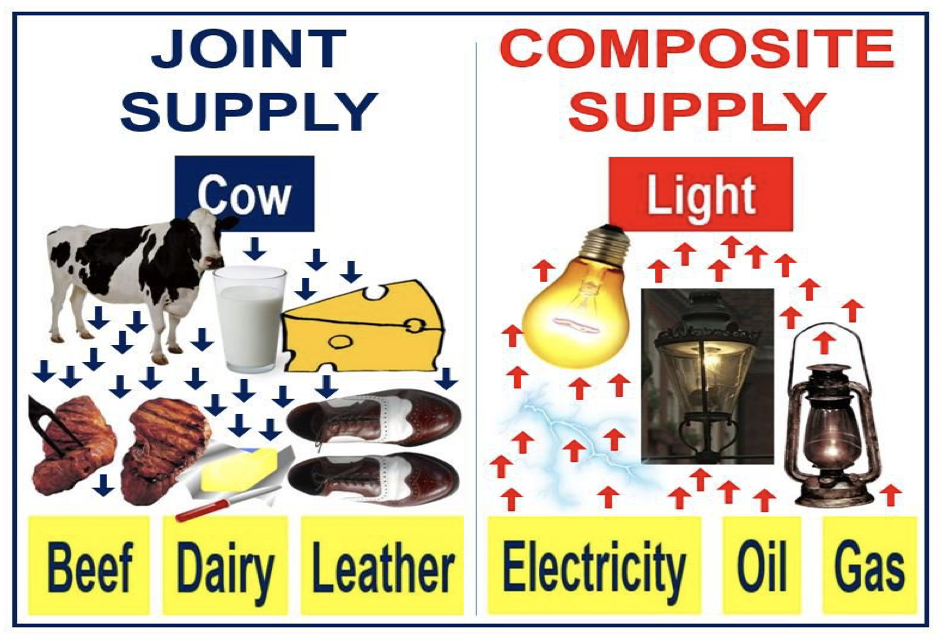The definition and meaning of joint supply refers to a product that can end up being at least two other types of goods. For example, a cow in a farm can be used for meat, milk, cheese, yogurt, and leather. Wheat production also delivers straw, which farmers, racetracks horse owners and other animal owners purchase for their stables, and biofuel (bioethanol).
Joint supply refers to either products or processes.
In joint supply, an increase or decline in the supply of the source product leads to a similar rise and fall in the supply of another product or by-product. The less important product in joint supply is called the by-product.

Joint supply is an economics term that describes a product that can result in at least two by-products. As you can see in this image, from sheep (and lambs) we get sheepskin, wool and mutton (or lamb’s meat).
For example, if a country produces more wheat, there is more straw for sale, if farmers this year produce more beef, there will also be more leather available.
Joint supply products availability closely linked
When demand for the source product changes, the supply of all its by-products is affected.
Rising demand for wool will trigger an increase in the supply of mutton or lamb, which will probably mean lower prices.
According to the Financial Times’ glossary of terms, joint supply is:
“The supply of more than one product from a single source, e.g.: mutton and wool, beef and milk, etc. Supplies of the products are inextricably linked, even though demand trends may differ.”
Controlling production of joint supply goods
With modern technology, it is possible to manipulate how much of a product and its by-products are available in a joint supply environment. For example, in New Zealand and Australia, people can now control the production of mutton and wool separately, by cross-breeding sheep.

While joint supply refers to one product and its several by-products, composite supply refers to a product that has two or more sources.
If demand for lamb or mutton rises, but farmers don’t want to destroy the market for wool traders by causing a glut, they select a breed of sheep which yields more meat and less wool for reproduction.
Some joint products are not possible to control – that is, not yet. The increase in output of the source product is automatically accompanied by a rise in the supply of the by-product. For example, if the price of cotton rises, cotton producers will try to produce more. This will automatically trigger an increase in the supply of cotton seed.
Joint supply vs. composite supply
We know that joint supply refers to a product and its by-products, for example, from sheep we get meat, leather, wool, milk and cheese – with composite supply the sources are multiple.
Composite supply refers to a product which has more than one source. If I want to light up a room, I can do so with candles, oil, kerosene, gas, or electricity. Light is the end product, while gas, electricity, etc. are examples of the composite supply.
Whenever there are rival sources of supply or substitutes, that supply is composite.
In most cases of composite supply, there is competition between the sources, with the most economical or readily-available one dominating the market.
In the production of electricity we have a case of composite supply. Electricity can be sourced from fossil fuels, wind energy, solar power, water movement, and nuclear fission. There is no point in having a car without buying gasoline, a printer without ink cartridges, or a razor without blades – these are examples of joint demand. As soon as you purchase one, you start buying the other.
There is no point in having a car without buying gasoline, a printer without ink cartridges, or a razor without blades – these are examples of joint demand. As soon as you purchase one, you start buying the other.
Joint supply vs. joint demand
Joint demand is not the opposite of joint supply – it is completely different.
If I buy a car I will also need to regularly buy gasoline or diesel. It is the same case with a printer and ink cartridges, a pencil and paper or sharpener, a horse and horse-food, a razor and razor blades. In all cases, if I don’t purchase both products, the original one is useless.
Joint demand exists when you need two products that go together.
Usually, an increase in the price of one will affect demand for the other. For example, if the price of gasoline jumps, demand for cars will probably fall, if ink cartridges become more expensive, demand for printers will likely decline and vice-versa.
Is composite demand the opposite of joint supply?
Perhaps the nearest opposite to joint supply is composite demand. Composite demand refers to demand for a product that has several different uses.
Humans demand wheat for making bread, producing biofuels, or feeding farm animals. Our land can be used for farming, building houses or offices, burying people, playing sports, etc. Steel can be used for building bridges, or making bicycles and automobiles.
In composite demand scenarios, the price and availability of a product’s different uses are affected. If we build more homes, there is less land available, which means farmland will probably become more expensive.
